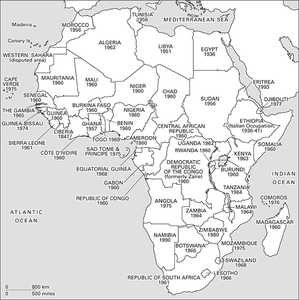The second largest continent, extending south from the Mediterranean Sea and bounded by the Atlantic and Indian oceans and the Red Sea.
Physical
The Equator passes through the middle of Africa, so that all but the very north and south are tropical, although regional differences in climate and landscape are vast. Most of northern Africa is desert, the only significant waterway being the Nile. The west, watered by the Niger and other rivers, is rich in tropical forests, though in many coastal regions there is only swamp. Inland, the ground rises first to savannahs and then to hilly, wooded plateaux in the centre of the continent. Here are some of the largest copper deposits in the world, and also deposits of gold, diamonds, uranium, cobalt, and other minerals. East Africa is a temperate region of great lakes, mountains, and high plateaux. It is split from north to south by the Great Rift Valley. South of the Zambezi River are more highlands, giving way in the south‐west to the Kalahari Desert. Then the land rises again, to the temperate veld. This good farming country is very rich in minerals. The southernmost coastal plain is ideal for fruit and plantation crops.
History
Evidence suggests that Africa was the birthplace of the human race, as shown by finds at Olduvai Gorge and other sites. By the late Stone Age Proto‐Berbers inhabited the north, Ethiopians the Nile valley, while Negroid peoples moved southwards. Pygmies occupied the central forest, and San and Khoikhoi (called Bushmen and Hottentots by White colonists) roamed the south.
By the 4th millennium bc, one of the world’s oldest civilizations had developed in Egypt. In the north Phoenicians, and then Carthaginians, organized sea‐borne empires which fell, with Egypt, to Rome in the last centuries bc. Indigenous kingdoms arose in Nubia and Aksum. In the 7th century the Arabs seized the north, bringing to it the religion and culture of Islam.
In Cameroon c.500 bc a population explosion sent the Bantu eastwards. They slowly occupied most of southern and central Africa, overwhelming the San people. There and in West Africa chieftainships developed, and some empires with sophisticated cultures, especially in Islamic states such as Mali and in Christian Ethiopia. Their intricate system of commerce reached from the Mediterranean to Indonesia and China. The Portuguese arrival in the 15th century heralded European intervention in Africa, stimulating trade in the west and centre, but interrupting it in the east. In the 16th century the north fell to the Ottomans, while south of the Sahara Europeans began the slave trade to the Americas. From the 16th to the 18th century in the present Democratic Republic of the Congo (formerly Zaïre) and in central Africa Bantu states developed, some of them sizeable empires. During this period the Bantu were pushing their way southwards, but it was not until the 19th century that they began to form recognizable states in the present South Africa. While each tribe or state developed its individual pattern of constitution, some more sophisticated than others, power was generally concentrated in the hands of chieftains and regulated both by tribal conventions and by free public discussion in tribal assemblies.
During the 19th century the interior was gradually opened up to European explorers, traders, and missionaries in an extensive programme of colonization. Imperialist sentiments and the desire to exploit the continent’s natural resources produced a series of military campaigns against the local states and tribes. By 1914 almost all Africa was ruled as colonies by European states. After World War I Germany’s former colonial empire was divided among the victorious Allies. After 1945 the rise of African nationalism accelerated the process of decolonization, most of the Black countries becoming independent between 1957 and 1980, sometimes as a result of peaceful negotiation and sometimes through armed rebellion. In Namibia (until 1990) and South Africa (until 1994), small White élites held on to political power, but elsewhere the descendants of the original inhabitants assumed responsibility for their own government. The artificial boundaries imposed by colonialism, the rapidity of the transition to home rule, and the underdeveloped state of many of the local economies produced political, social, and economic problems of varying severity all over the continent. Many of the new nations remained unstable and politically impoverished, while drought in the 1980s and early 1990s in both East and Southern Africa caused terrible suffering. Multiparty democracies, which replaced single‐party regimes in many African countries in the early 1990s, inherited vast burdens of World Bank and IMF debt. By the early 21st century an AIDS pandemic threatened a population catastrophe in sub‐Saharan Africa: about 10% of the adult population has HIV or AIDS, rising to over 20% in southern Africa, and average life expectancy is decreasing.

African decolonization. Agitation for political independence was strong in Islamic North Africa before World War II, but south of the Sahara the first Black African independent state to emerge was Ghana (1957). Within decades, White minority rule was confined to South Africa and Namibia. The map shows the years in which the modern African states became independent and gives their modern, rather than colonial-era, names.
Source: MAPS IN MINUTES™ © RH Publications (1997)
- microclimates
- microcline
- microcode
- microcomputer
- microcontinent
- microcontroller
- microcosm
- microcraters
- micro-credit
- microcrystalline
- microcrystal test
- microdiorite
- microdissection
- microearthquake
- microeconometrics
- microeconomics
- microelectrode
- microelectromechanical sensors
- microelectronics
- microerosion meter
- microevolution
- microfabric
- microfauna
- microfibril
- microfiche